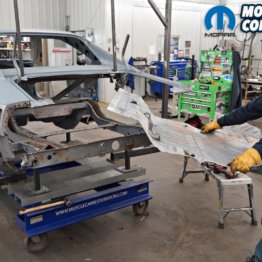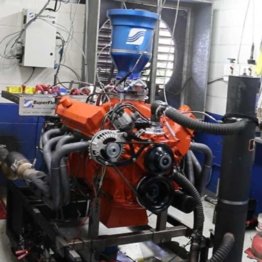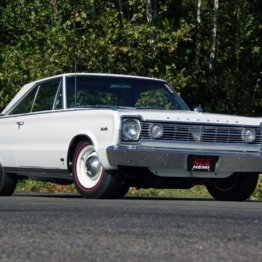
As the 1970s launched, the auto manufacturers were taking hits on all fronts. The Feds were pressuring manufacturers to adhere to increasingly stringent emissions standards, and stricter occupant safety benchmarks loomed. Even worse, the youth car buyers were being pinched out of the market with surcharges the insurance companies applied to all high-performance models.
Although faced with these insurmountable challenges, Plymouth introduced an all-new 1971 GTX with its innovative-looking “fuselage” design. Even with the swoopy, flowing lines, and looping front bumper and grill, the GTX could not escape its inevitable fate. 1971 proved to be the swan song for the “gentleman’s muscle car” as a stand-alone Plymouth model. Due to the stringent emissions measures of the Air Quality Act of 1967, the 426 Hemi would also meet its demise at the end of the 1971 model year.

Before the end of production, Plymouth produced 2,942 GTX models in 1971. Of those GTXs, only 30 left the factory with a Hemi (eleven with a 4-speed and nineteen with a Torqueflite). Al Macdonald, of Newville, PA, owns one of the eleven 4-speed Hemis. Although owning a one of eleven car is extremely rare, Macdonald also owns a 1964 Dodge Polara 500 with a factory Max Wedge, which is just one of five. For over 40 years, Macdonald has made a living buying and selling Mopar NOS parts and literature, auto magazines, and records. Because of his background, he has contacts to help him track down rare vehicles and parts.
Macdonald purchased the Plymouth in March 2019, but the GTX’s history remains a mystery. He found the original purchaser’s name, but he does not know how many previous owners enjoyed the GTX. Manufactured in St. Louis, the GTX ended up selling from Pueblo Dependable Dodge in Colorado. Yes, a Dodge dealership sold a new Plymouth. A behind-the-scenes dealership vehicle swap transaction occurred with a Plymouth dealer, which strangely left a Dodge dealership with a new Plymouth to sell.

The GTX remained in Colorado until Macdonald had it shipped to Pennsylvania. When Macdonald purchased the GTX, he knew the Hemi was not the original engine. Unfortunately, someone pulled the potent Hemi years ago and dropped it into a drag race car. From there, the Hemi’s history goes cold; there is no information about the condition or even the existence of the engine. The current Hemi nestled in the engine bay is factory-correct, but underneath the mammoth, Hemi cylinder heads spins a stroker reciprocating assembly. With a 4.31-inch stroke, the Hemi now displaces an additional sixty-four cubes pushing the cubic inch displacement to just under 490 cubes.
With nothing more than a gasket port match, the cylinder heads remain in a stock condition. The intake and exhaust valves remain the original size, and factory 1.5:1 rocker arms actuate them. The camshaft is an unlisted hydraulic grind with a 0.535-inch intake valve lift and a 0.520-inch exhaust lift. The advertised intake duration is 291° (230° @ 0.050”), and the exhaust duration is 295° (235° @ 0.050”). The heads dump the spent hydrocarbons into factory exhaust manifolds. A custom 2.5-inch exhaust attaches the exhaust manifolds to the factory resonators and slotted exhaust tips.

After almost two decades of Colorado weather, the aged exterior of the GTX received a rejuvenating in the late-1980s. The rust-free body got a fresh coat of factory Plymouth color Curious Yellow (GY3). New old stock (NOS) stripes and emblems were installed over the fresh paint, and to round out the exterior update, a NOS vinyl top was glued to the roof area of the GTX.
The GTX originally came with 14-inch steel wheels and full wheel covers. However, Macdonald wanted a more aggressive look, so he enhanced the GTX’s appearance with four Ford Magnum 500 wheels wrapped with reproduction Goodyear G60-15 Polyglas GT bias-ply tires. Slowing the GTX is a manual brake system equipped with 11 ½-inch front drums coupled with a pair of 11 ½-inch drums hung on the Dana 60 rear end. The Dana has the factory 3.54:1 gears that multiply the torque received from the New Process A-833 4-speed transmission. Before Macdonald purchased the GTX, the brakes, suspension, transmission, and the Dana 60 had been rebuilt to factory specs.

Macdonald was never pleased with how the engine ran; it had less than stellar performance. The twin Carter AFBs were in poor shape and did not respond to any tuning attempts Macdonald made. An incorrect intake manifold and mismatched air cleaner assembly broadened the induction concerns. To resolve the carburetion woes, Macdonald sent a pair of year-correct (M-stamp) carburetors to Scott Smith, owner of Harms Carburetor Restoration, for a complete rebuilding. Smith applied his magic on the AFBs and returned a pair of beautifully rebuilt 1971 Carter AFB carbs.
In 1971, the Hemi production was extremely low, so many of the AFBs were holdover 1970 “L” stamped carbs re-stamped by the factory with an “M” to represent the 1971 model year. To correct the rest of the induction system, Macdonald mounted the twin Carters onto a factory 1971 intake manifold and covered the carbs with a factory air cleaner housing.

The Hemi ran significantly better, but it still seemed down on power. The dual-point distributor gave Macdonald fits, so as a stop-gap, he fitted a single-point distributor into the Hemi to smooth out the ignition problems. Macdonald plans to update the dual-point distributor with a Pertronix electronic ignition pickup and trigger to resolve the distributor’s concerns permanently. The rest of the electrical components, such as the starter, alternator, regulator, coil, and plug wires are either properly date-coded rebuilt originals or date-coded NOS replacement parts.
In his brief ownership, Macdonald has transformed the Hemi into an easy to start, well-behaving engine. He has acquired the correct date-code parts needed for the GTX and has detailed every component. The GTX quickly earned an Antique Automobile Club of America (AACA) Junior award. With additional attention to detail, the GTX received its AACA Senior award at the 2019 Hershey Eastern Fall Meet. Regardless of its value or AACA status, Macdonald purchased the GTX to drive. On the day of the photoshoot, he drove the four-wheel manual drum brake, bias-ply tire GTX over 100 miles. Macdonald claims the fuel mileage is in the low- to mid-teens. The Hemi purrs like a kitten in traffic, but rest assured, with a deliberate stomping of the loud pedal, the Hemi will emit the intimidating roar of an Elephant.













































 Mopar Connection Magazine – The ONLY Daily Mopar Magazine © 2022. All Rights Reserved. Mopar Connection Magazine is the ONLY daily Mopar Magazine bringing you the latest Mopar news, technology, breaking news, and Mopar related events and articles. Find out the latest information about Mopar, Mopar products and services, stay up to date on Mopar enthusiast news, dealership information and the latest Mopar social media buzz! Sign up for the Mopar Connection Magazine newsletter for the latest information about new products, services and industry chatter. Mopar Connection Magazine is the best and only source you need to be a Mopar industry insider!
Mopar Connection Magazine – The ONLY Daily Mopar Magazine © 2022. All Rights Reserved. Mopar Connection Magazine is the ONLY daily Mopar Magazine bringing you the latest Mopar news, technology, breaking news, and Mopar related events and articles. Find out the latest information about Mopar, Mopar products and services, stay up to date on Mopar enthusiast news, dealership information and the latest Mopar social media buzz! Sign up for the Mopar Connection Magazine newsletter for the latest information about new products, services and industry chatter. Mopar Connection Magazine is the best and only source you need to be a Mopar industry insider! by
by